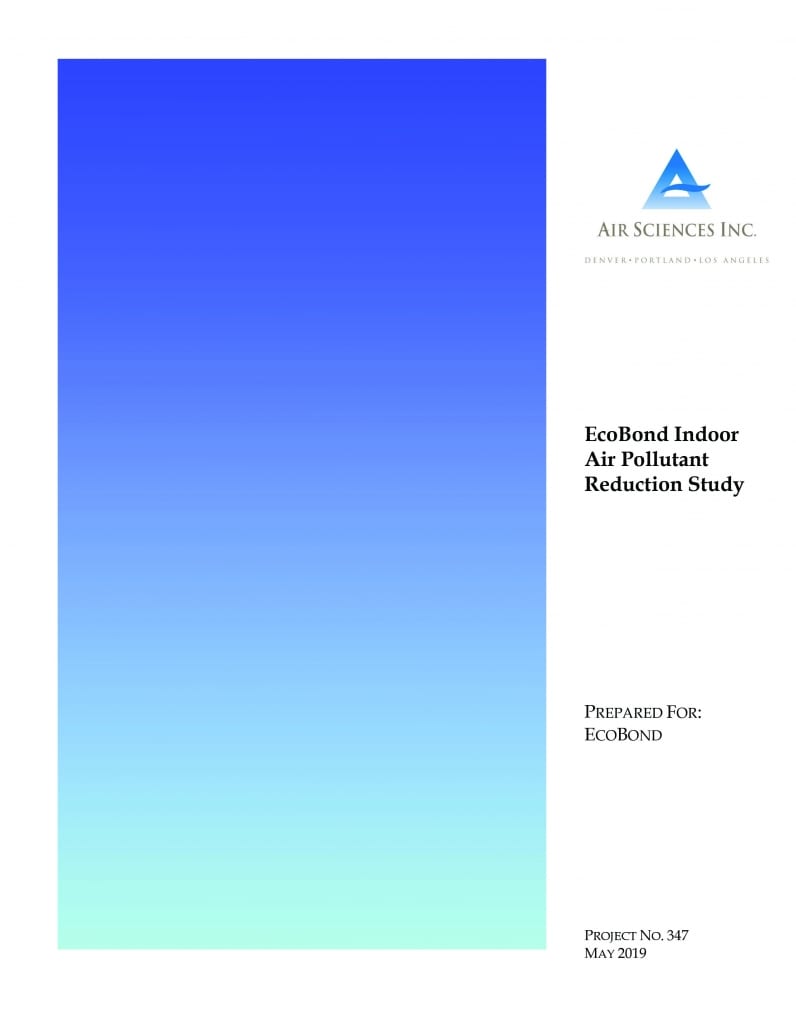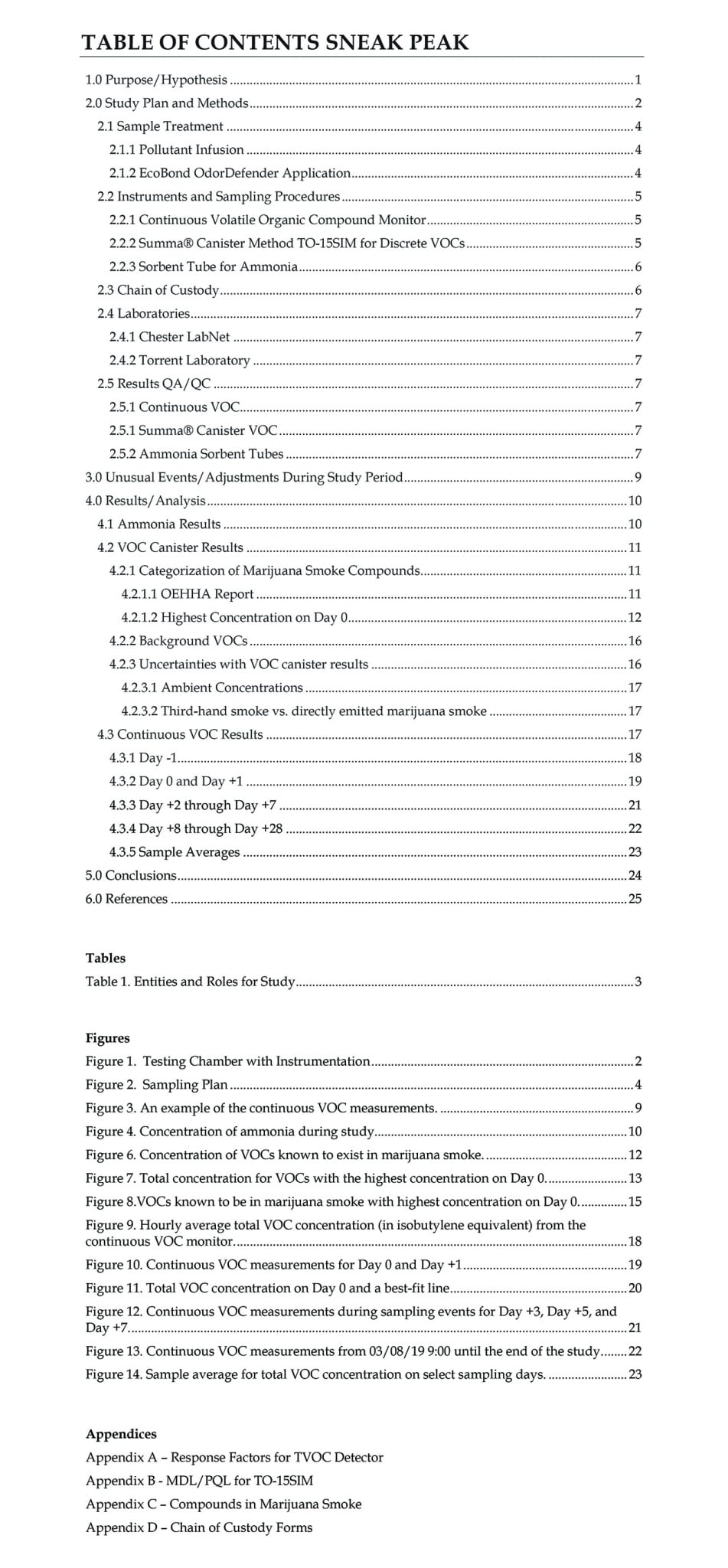LABORATORY RESULTS | THIRD PARTY
ECOBOND® INDOOR AIR POLLUTANT REDUCTION STUDY EXECUTIVE SUMMARY:
The objective of the Ecobond® Indoor Air Quality study was to validate that Ecobond® Odor Defender effectively reduces hazards and odors from thirdhand smoke and ammonia (pet urine) significantly improves indoor air quality. The study proves that Ecobond® OdorDefender substantially reduced scientifically measured emissions originating from reemitted hazardous indoor air pollutants. Ecobond® OdorDefender provides a simple paint on solution to reducing common indoor air quality hazards, thus improving the indoor air quality.
1. Introduction
Ecobond® OdorDefender® (EOD) is a specialty developed, professional grade, high quality paint infused with Eco-Friendly, highly effective odor blocking and odor absorbing minerals, and biopolymers. It is specifically designed for sealing and blocking dangerous fumes, and lingering odors resulting from the secondary effects of marijuana, cigarette, fire smoke, and pet urine. EOD will help seal and block odors and smoke residue to improve healthy indoor air quality standard.
2. Hazards of Residual Smoke
New scientific studies show that smoke residue will re-emit hundreds of volatile organic compounds (VOCs) long after a smoker has vacated the premises1. It has been documented that both tobacco and marijuana share many VOCs2 so the results of this experiment are pertinent to both marijuana and tobacco smoke. For this experiment, marijuana was chosen as the primary pollutant because of its similarity to tobacco emissions and unique smell. Using the list of compounds identified in marijuana smoke by the Office of Environmental Health Hazard Assessment (OEHHA), several of these can be detected using method TO-15: acetaldehyde, acetone, benzene, 1,3-butadiene, methyl ethyl ketone (MEK or 2-butanone), naphthalene, styrene, and toluene. A subset of these, (acetaldehyde, benzene, 1,3-butadiene, and naphthalene) have been identified as being cancerous by OEHHA and the State of California. For this experiment, total VOCs were measured as well as specific compounds that were chosen to demonstrate the versatility of EOD’s capabilities; acetone, MEK, and naphthalene. Ammonia was measured as pet urine is a common indoor air quality contaminant as the urea in urine breaks down over time into ammonia3.
3. National Expert Air Quality Testing Company
Air Sciences Inc. was chosen to perform the air quality study to identify and quantify compounds emitted from exposed material before and after the application of EOD. Air Sciences is a nationally recognized, industry leading expert that specializes in air pollution and air quality. They have 30+ years of experience in service for both industry and government including mineral extraction and refining, power production, natural gas processing, chemical manufacturing, painting processes, and pesticide formulation. They have worked closely with both the EPA and federal land managers.
4. Experimental Program
The 30-day study took place from February 26, 2019 until March 28, 2019. High concentrations of marijuana were infused into drywall to simulate a house that had been smoked in for many years. Additionally, a high concentration of ammonia was used to simulate many years of pet urine contamination. VOCs were measured continuously using an APIS-AQ monitor configured with a Total VOC (TVOC) detector, H2S detector, NO2 detector, and CO detector. It is not possible to measure the concentration of each individual component using this instrument unless the percentage of each volatile is both fixed and known. Since the concentration of all VOCs in the chamber is not known (only a subset of total VOCs is characterized with the canister and TO-15), the signal reported is the sum of all VOCs.
Specific VOCs were measured for discrete time periods of 8-hours using Summa® Canister Method TO-15SIM. The cleaned and evacuated canisters were provided to Air Sciences by Torrent Laboratory located in California. The sampled canisters were returned to Torrent Laboratory and analyzed using EPA Compendium Method TO-15 (EPA 1999) in selected ion mode (SIM). A total of seven Summa canister samples were taken over the course of this study. Ammonia was measured via sorbent tubes. The sorbent tubes have a silica gel that has been pre-treated with sulfuric acid inside that will adsorb ammonia. The ammonia samples were analyzed with ion chromatography (IC). This analysis was performed according to NIOSH method 6016 by Chester LabNet, located in Oregon. A total of eight sorbent tube samples were taken over the course of this study.
The study began with sampling of the raw, unpainted and uncontaminated media in the ambient chamber (referred to as Day -1). The media were then infused by taking drywall material (10” by 10”) that was placed into an enclosed container equipped with a vacuum pump and marijuana incineration area. Over a ~ 5-hour period, one half ounce of marijuana was incinerated, and the smoke was pulled into the container and allowed to impregnate the drywall. For the ammonia samples, a Whatman 1 filter (cut to ~ 2 ⅝”) was placed on top of a glass jar and sealed with the metal screw-on band with 50 mL of 14.4% ammonium hydroxide placed into the jar.
The contaminated materials were then sampled in the chamber (Day 0). The contaminated drywall was coated with EOD. The coating was 8 mil thick wet and 4 mil thick dry. Then, the Whatman 1 filters were coated with EOD. The filter for the ammonia test was painted using a foam brush and a single coat of EOD was used at 8 mil thick wet. This was then allowed to dry overnight resulting in a 4 mil thickness.
The EOD painted drywall and filter were placed in the chamber and left for the duration of the study. The sampling day, referred to as Day +1, was taken after the painted materials were placed in the chamber. The sampling continued until Day +28.
5. Experimental Results
On Day 0, the detector had a maximum reading of 3300 ppm. The sample average decreases after Day +1 and is approximately the same on Day +28 (252.9 ppm) as on Day -1 (242.2 ppm). This is a measurable 92.3% decrease in VOCs from Day 0. This reduction was probably greater, however, was unquantifiable due to the detector maxing out at 3300 ppm. The concentration of MEK on Day +28 (3.39 μg/m3) had decreased by more than 90% from the concentration on Day 0 (39.11 μg/m3), which suggests a significant decrease in the rate of emission to below the odor threshold of 15.93 μg/m3,(5) if not a full arrest. The concentration of naphthalene decreased by 73.1% from 1.4 μg/m3 on Day 0 to 0.377 μg/m3 on Day +28. This is almost the same as the concentration on Day -1 (0.403 μg/m3), suggesting that this VOC is also brought to full arrest. Similarly, the concentration of acetone decreased by an average of almost 75% after the application of EOD. Yet, acetone does increase to the second highest concentration on Day +28. Since acetone is prevalent in the atmosphere4, it is entirely possible that during Day +28 there were higher ambient concentrations of acetone compared to the rest of the sampling days. The vapor pressure of acetone at 25 °C is ~0.3 bar, of naphthalene is less than 0.01 bar, and 2-butanone is less than 0.25 bar (NIST webbook). While the vapor pressures of naphthalene and 2-butanone are not quantified at 25 °C, comparison of the vapor pressures at higher temperatures indicate that acetone is the most likely to be re-emitted, followed by 2-butanone then naphthalene. Therefore, the complete blockage of 2-butanone and naphthalene from emission by Day +28 by EOD indicates that other lower volatility compounds present in marijuana smoke (e.g. α-pinene or β-caryophyllene) would also be blocked from emission.
The application of EOD reduces the emissions from ammonia by 99% from a hazardous level (OSHA TWA for ammonia is 35 µg/L) to a level undetectable by the human nose (3 µg/L). The ammonia (NH3) concentration on Day 0 was 36.15 µg/L air. The concentration of ammonia measured in the chamber sharply decreased on Day +1 (4.97 µg/L air) and continued to decrease through Day +28 (0.372 µg/L air).
6. Conclusion
Indoor air quality was vastly improved by the application of Ecobond® OdorDefender.
- Ammonia concentration was reduced by 99%
- Total VOC was reduced by 92.3%
- MEK was reduced by 90%
- Complete arrest of naphthalene
- Acetone was reduced by 75%
Based on the results from the total VOC analysis and the individual compound analysis, this study provides scientific proof that when applied to a surface that has been exposed to the hazards of thirdhand smoke or ammonia caused from pet urine, Ecobond® OdorDefender® paint reduces the emissions of toxic VOC’s associated with third hand smoke and ammonia, thus providing substantially improved indoor air quality.
INTERESTED IN THE FULL 57 PAGE AIR SCIENCES OFFICIAL LAB REPORT?
DOWNLOAD BELOW.
ECOBOND® INDOOR AIR POLLUTANT REDUCTION STUDY & INDUSTRY REPORT
Thirdhand Smoke & “Indoor Air Pollutant Reduction Study”
Are your cleaning products activating Thirdhand Smoke on your walls?





